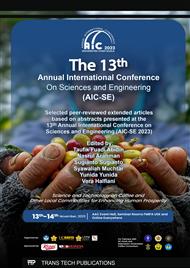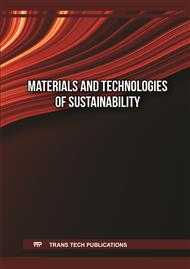[1]
M. Maletic, M. Vukcevic, A. Kalijadis, I. Jankovic-Castvan, A. Dapcevic, Z. Lausevic, M. Lausevic, Hydrothermal synthesis of TiO2/carbon composites and their application for removal of organic pollutants, Arab. J. Chem. 12 (2019) 4388–439.
Google Scholar
[2]
A. Oluwole, E. O. Omotalo, O. S. Olatunji, Pharmaceuticals and personal care products in water and wastewater: a review of treatment processes and use of photocatalyst immobilized on functionalized carbon in AOP degradation, BMC Chem. 14 (2020) 29 pages.
DOI: 10.1186/s13065-020-00714-1
Google Scholar
[3]
A. Sudhaik, P. Raizada, P.Shandilya, D. Y. Jeong, J.H. Lim, P. Singh, Review on fabrication of graphitic carbon nitride based efficient nanocomposites for photodegradation of aqueous phase organic pollutants, J. Ind. Eng. Chem. 67 (2018) 28–51.
DOI: 10.1016/j.jiec.2018.07.007
Google Scholar
[4]
S. Sharma, V. Dutta, V. P. Singh, P. Raizada, A. Rahmani-Sani, V.K. Thakur, Carbon quantum dot supported semiconductor photocatalysts for efficient degradation of organic pollutants in water: a review, J. Clean. Prod. 228 (2019) 755-769.
DOI: 10.1016/j.jclepro.2019.04.292
Google Scholar
[5]
V. Hasija, P. Raizada, A. Sudhaik, K. Sharma, A. Kumar, P. Singh, S.B. Jonnalagadda, V.K. Thakur, Recent advances in noble metal free doped graphitic carbon nitride based nanohybrids for photocatalysis of organic contaminants in water: a review, Appl. Mater. Today 15 (2019) 494–524.
DOI: 10.1016/j.apmt.2019.04.003
Google Scholar
[6]
J. Matos, S. Miralles-Cuevas, A. Ruíz-Delgado, I. Oller, S. Malato, Development of TiO2-C photocatalysts for solar treatment of polluted water, Carbon 122 (2017) 361–373.
DOI: 10.1016/j.carbon.2017.06.091
Google Scholar
[7]
X. Tang, Z. Wang, Y. Wang, Visible active N-doped TiO2/reduced graphene oxide for the degradation of tetracycline hydrochloride, Chem. Phys. Lett. 691 (2018) 408–414.
DOI: 10.1016/j.cplett.2017.11.037
Google Scholar
[8]
C. Thambiliyagodage, Efficient photocatalysis of carbon coupled TiO2 to degrade pollutants in wastewater – a review, Environ. Nanotechnol. Monit. Manag. 100737 (2022).
DOI: 10.1016/j.enmm.2022.100737
Google Scholar
[9]
B. Xing, C. Shi, C. Zhang, G. Yi, L. Chen, H. Guo, G. Huang, J. Cao, Preparation of TiO2/activated carbon composites forphotocatalytic degradation of RhB under UV light irradiation, J. Nanomater. (2016) 8393648.
DOI: 10.1155/2016/8393648
Google Scholar
[10]
E. M. El Mouchtari, D. Claude, S. Rafqah, F. Najjar, H. Anane, A. Piram, A. Hamadeh, S. Briche, P. Wong-Wah-Chung, TiO2 and activated carbon of argania spinosa tree nutshells composites for the adsorption photocatalysis removal of pharmaceuticals from aqueous solution, J. Photochem. Photobiol. A: Chem. 112183 (2020).
DOI: 10.1016/j.jphotochem.2019.112183
Google Scholar
[11]
A. Amorós-Pérez, M. A. Lillo-Ródenas, M.D.C. Román-Martínez, P. García-Muñoz, N. Keller, TiO2 and TiO2-carbon hybrid photocatalysts for diuron removal, Catalysts, 11 (2021) 457.
DOI: 10.3390/catal11040457
Google Scholar
[12]
M. Mariana , E. M. Mistar, T. Alfatah, M. D. Supardan, High-porous activated carbon derived from Myristica fragrans shell using one-step KOH activation for methylene blue adsorption, Bioresour. Technol. 16(2021) 100845.
DOI: 10.1016/j.biteb.2021.100845
Google Scholar
[13]
Nurjannah, R. Yulianti, A. Marzuki, S. Kasim and N. J. N. Djide, Analisis residu pestisida klorpirifos pada beras (oryza sativa) yang berasal Kecamatan Baebunta Kabupaten Luwu Utara, Majalah Farmasi dan Farmakologi, 23(3) (2019) 109-111.
DOI: 10.20956/mff.v23i3.9402
Google Scholar
[14]
Fahmi, Analisis residu pestisida pada beras tangse kabupaten pidie menggunakan metode kromatografi gas – Electron Capture Detector (ECD), Skripsi, UIN Ar-raniry, Banda Aceh, 2021.
Google Scholar
[15]
A. Saiya, D, Gumolung, D.H.O, Howan, Analisis residu klorpirifos dalam sayuran kubis dengan metode HPLC di beberapa pasar tradisional di Sulawesi Utara, Eksakta, 18(2) (2017) 77-85.
DOI: 10.24036/eksakta/vol18-iss02/57
Google Scholar
[16]
Damaiyanti, R. Yulianty, A. Marzuki, S. Kasim, H. Rante, Analisis residu pestisida klorpirifos pada cabai (capsicum sp.) dari Desa Bungin Kecamatan Bungin Kabupaten EnrekangMajalah Farmasi dan Farmakologi, 23(3) (2019) 106-108.
DOI: 10.20956/mff.v23i3.9401
Google Scholar
[17]
F.J. Benitez, F.J. Real, J.L. Acero, C. Garcia, Photochemical oxidation pprocesses for the elimination of phenyl-urea herbicides in waters, J. Hazard. Mater., 138(2) (2006) 278–287.
DOI: 10.1016/j.jhazmat.2006.05.077
Google Scholar
[18]
A. Kurnia, Analisis residu klorpirifos pada tanah dan validasinya, Jurnal Agrikultura, 29(2) (2018) 61–65.
DOI: 10.24198/agrikultura.v29i2.19247
Google Scholar
[19]
S. Farahbakhsh, R. Parvari, A. Zare, H. Mahdizadeh, V. Faizi V, A. Saljooqi, Preparation of biochar based on grapefruit peel and magnetite decorated with cadmium sulfide nanoparticles for photocatalytic degradation of chlorpyrifos, Diam. Relat. Mater. 126 (2022) 109130.
DOI: 10.1016/j.diamond.2022.109130
Google Scholar
[20]
S. Dubale, D. Kebebe, A. Zeynudin, N. Abdissa, S. Suleman, Phytochemical screening and antimicrobial activity evaluation of selected medicinal plants in Ethiopia, J. Exp. Pharmacol. 15(2023) 51–62.
DOI: 10.2147/jep.s379805
Google Scholar
[21]
A. M. Amanulla, R. Sundaram, Green synthesis of TiO2 nanoparticles using orange peel extract for antibacterial, cytotoxicity and humidity sensor applications, Mater. Today: Proc. 8 (2019) 323-331.
DOI: 10.1016/j.matpr.2019.02.118
Google Scholar
[22]
G. Kandregula, A. Chinthakuntia, K. V. Rao, S. Chidurala, Synthesis of TiO2 nanoparticles from orange fruit waste, Int. J. Adv. Multidiscip. 2(1) (2015) 82-90.
Google Scholar
[23]
M. Nadeem, D. Tungmunnithum, C. Hano, B. H. Abbasi, S. S. Hashmi, W. Ahmad, A. Zahir, The current trends in the green synthesis of titanium oxide nanoparticles and their applications, Green Chem. Lett. Rev. 11(2018) 492-502.
DOI: 10.1080/17518253.2018.1538430
Google Scholar
[24]
M. Srinivasan, M., Venkatesan, V. Arumugam, G. Natesan, N. Saravanan, N., S. Murugesan, S. Ramachandran, R. Ayyasamy, A. Pugazhendhi, Green synthesis and characterization of titanium dioxide nanoparticles (TiO2 NPs) using Sesbania grandiflora and evaluation of toxicity in zebrafish embryos, Process Biochem. 80 (2019) 197-202.
DOI: 10.1016/j.procbio.2019.02.010
Google Scholar
[25]
B. Mondol, A. Sarker, A.M. Shareque, S.C. Dey, M. T. Islam, A. K. Das, S. M. Shamsuddin, M.A.I. Molla, M. Sarker, Preparation of activated carbon/TiO2 nanohybrids for photodegradation of reactive red-35 dye using sunlight, Photochem 1 (2021) 54-66.
DOI: 10.3390/photochem1010006
Google Scholar
[26]
D. Huang, Y. Miyamoto, T. Matsumoto T. Tojo, T. Fan, J. Ding, Q. Guo, D. Zhang, Preparation and characterization of high-surface-area TiO2/activated carbon by low-temperature impregnation Sep. Purif. Technol. 78(1) (2011) 9–15.
DOI: 10.1016/j.seppur.2011.01.010
Google Scholar
[27]
M. Baca, K. Wenelska, E. Mijowska, J. R. Kalenzuk, B. Zielinska, Physicochemical and photocatalytic characterization of mesoporous carbon/titanium dioxide spheres, Diam. Relat. Mater. Materials 101 (2020) 107551.
DOI: 10.1016/j.diamond.2019.107551
Google Scholar
[28]
J. Zhang, Q. Liu, J. Wang, H. He, F. Shi, B. Xing, J. Jia, G. Huang, C. Zhang, Facile preparation of carbon quantum dots/TiO2 composites at room temperature with improved visible-light photocatalytic activity J. Alloys Compd. 869 (2021) 159389.
DOI: 10.1016/j.jallcom.2021.159389
Google Scholar
[29]
N. M. Zain, C. M. Lim, A. Usman, N. Keasberry, R. Thotagamuge, A. H. Mahadi, Synergistic effect of TiO2 size on activated carbon composites for ruthenium N-3 dye adsorption and photocatalytic degradation in wastewater treatment, Environ. Nanotechnol. Monit. Manag. 16 (2021)100567.
DOI: 10.1016/j.enmm.2021.100567
Google Scholar
[30]
J. T. Carneiro, T.J. Savenije, J.A. Moulijn and G. Mul, How phase composition influences optoelectronic and photocatalytic properties of TiO2, J. Phys. Chem. C 115 (2011) 2211–2217.
DOI: 10.1021/jp110190a
Google Scholar
[31]
S. P. Goutam, G. Saxena, V. Singh, A.K. Yadav, R.N. Bharagava, K.B. Thapa, Green synthesis of TiO2 nanoparticles using leaf extract of Jatropha curcas L.for photocatalytic degradation of tannery wastewater, Chem. Eng. J. 336 (2018) 386-396.
DOI: 10.1016/j.cej.2017.12.029
Google Scholar
[32]
M.Y. Ghaly, T.S. Jamil, I.E. El-Seesy, E.R. Souaya, R.A. Nasr, Treatment of highly polluted paper mill wastewater by solar photocatalytic oxidation with synthesized nano TiO2, Chem. Eng. J. 168 (2011) 446–454.
DOI: 10.1016/j.cej.2011.01.028
Google Scholar
[33]
A. Singh, V. Goyal, J.Singh, Mo. Rawa, Structural, morphological, optical and photocatalytic properties of green synthesized TiO2 NPs, Curr. Res. Green sustainable Chem. 3 (2020) 100033.
DOI: 10.1016/j.crgsc.2020.100033
Google Scholar
[34]
G. Nabi, A. Majid, A. Riaz, T. Alharbi, M. A. Kamran, M. Al-Habardi, Green synthesis of spherical TiO2 nanoparticles using Citrus Limetta extract: Excellent photocatalytic water decontamination agent for RhB dye, Inorg. Chem. Commun. 129 (2021) 108618.
DOI: 10.1016/j.inoche.2021.108618
Google Scholar
[35]
P. Singh, M.C. Vishnu, K. K. Sharma, A. Borthakur, P. Srivastava, D. B. Pal, D. Tiwary, P.K. Mishra, Photocatalytic degradation of acid red dye stuff in the presence of activated carbon-TiO2 composite and its kinetic enumeration, J. Water Process Eng. 12 (2016) 20–31.
DOI: 10.1016/j.jwpe.2016.04.007
Google Scholar
[36]
W. Xu, Y. Jin, Y. Ren, J. Li, Z.Wei, C.Ban, H. Cai, M. Chen, Synergy mechanism for TiO2/activated carbon composite material: Photocatalytic degradation of methylene blue solution, Can. J. Chem. Eng. (2021) 1–15.
DOI: 10.1002/cjce.24097/v2/response1
Google Scholar
[37]
W. Li, D. Du, T. Yan, D. Kong, J. You, D. Li, Relationship between surface hydroxyl groups and liquid-phase photo catalytic activity of titanium dioxide, J. Colloid Interface Sci. 444 (2015) 42–
DOI: 10.1016/j.jcis.2014.12.052
Google Scholar
[38]
T. Somsiripan, C. Sangwichien, Enhancement of adsorption capacity of Methylene blue, Malachite green, and Rhodamine B onto KOH activated carbon derived from oil palm empty fruit bunches, Arab. J. Chem, 16(2023) 105270.
DOI: 10.1016/j.arabjc.2023.105270
Google Scholar
[39]
H. Chen, Y. Yang, M. Hong, J. Chen, G, Suo, X. Hou, L. Feng, Z. Chen, Separable and recyclable meso-carbon@TiO2/carbon fiber composites for visible-light photocatalysis and photoelectrocatalysis, Sustain. Mater. Technol. 21 (2019) e00105.
DOI: 10.1016/j.susmat.2019.e00105
Google Scholar
[40]
Y. Hou, Q. Lu, H. Wang, H. Li, Y. Zhang, S. Zhang, One-pot electrochemical synthesis of carbon dots/TiO2 nanocomposites with excellent visible light photocatalytic activity, Mater. Lett. 173 (2016) 13–17.
DOI: 10.1016/j.matlet.2016.03.003
Google Scholar



